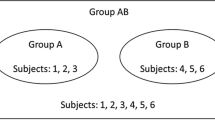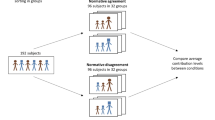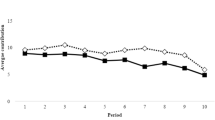Abstract
This paper analyzes the impact of inequality in the distribution of endowments on cooperation. We conduct a lab experiment using a dynamic Public Good Game to test this relation. We introduce the possibility of choosing among three different redistribution rules: Equidistribution, Proportional to contribution and Progressive to endowment. This novelty in a dynamic environment allows us to analyze how the inequality within groups changes according to individual choices and to investigate if players show inequity averse preferences. Results show that inequality has a negative impact on individual contribution. Players act in order to reduce the initial exogenous inequality. Indeed, in the Treatment with the highest level of inequality, agents vote for reducing the endowment heterogeneity. Moreover, individual contribution is strongly influenced by others’ contributions.







Similar content being viewed by others
Notes
As in Fehr and Gatcher (2000), reciprocity is a conditional form of kindness, that is kind behavior is conditioned by other kind behavior.
We recommend and control that the communication is useful only for the scope of the game. Indeed, group message flow was monitored to ensure that they did not reveal their identity to others.
We sent an invitation email to 120 students but only 105 finally partcipated. This is a standard procedure in experiments in which a prefixed number of participant is needed. It is necessary to invite more people than the effective number in order to avoid the problem of no-show players.
It is important to underline that in our experiment the maximum earning per person is 25 Euro. As in Croson (2005), we consider as reference point the hourly wage of a on-campus job which is equal to 10 Euro.
We also run a parametric test (t test) even if we have few observations. The results of the parametric test also reject the null hypothesis since for both Treatment 2 and Treatment 3 we have \(p\,\mathrm{value} <\)0.01.
In the 90 % of cases the decision is taken unanimously.
The payoff function depends both on the exogenous endowment and on the share of contribution in the previous period. This implies that the regressors are not exogenous. In other words, in our setting it should be the case that \(E(x_{it}\epsilon _{it})\ne 0\). To verify this hypothesis we should consider an estimation with Instrumental variables. We are not able to run this regression because we have no exogenous variables to use as instruments.
The distinction between rich and poor players are done according to the initial endowment. Type 1 and Type 2 are the rich players. Despite the strong reduction of the degree of inequality, the average endowment of Type 1 and Type 2 are always grater than the endowment of others.
In fact, even efficiency motivations such as the sustain of both the aggregate demand in the short-to-medium run and the economic growth in the long run would motivate radical interventions, that is more progressivity in the taxation system and also large tax rate on inheritance Atkinson (2015).
References
Anderson LR, Mellor JM, Milyo J (2008) Inequality and public good provision: an experimental analysis. J Socio Econ 37:1010–1028
Atkinson AB (2015) Inequality: what can be done? Harvard University Press, Cambridge
Balafoutas L, Kocher MG, Putterman L, Sutter M (2013) Equality, equity and incentives: an experiment. Eur Econ Rev 60:32–51
Bicchieri C, Lev-On A (2007) Computer-mediated communication and cooperation in social dilemmas: an experimental analysis. Polit Philos Econ 6(2):139–168
Buckley E, Croson R (2006) Income and wealth heterogeneity in the voluntary provision of linear public good game. J Public Econ 90:935–955
Burns J, Visser M (2008) Income inequality and the provision of public goods: when the real world mimic the lab. Working Paper
Cardenas JC (2003) Real wealth and experimental cooperation: experiments in the field lab. J Dev Econ 70:263–289
Chan KS, Mestelman S, Moir R, Muller RA (1999) Heterogeneity and the voluntary provision of public goods. Exp Econ 2(2):5–30
Cherry TL, Kroll S, Shogren JF (2005) The impact of endowment heterogeneity and origin on public good contributions: evidence from the lab. J Econ Behav Org 57:357–365
Cooper R, DeJong DV, Forsythe R, Ross TW (1996) Cooperation without reputation: experimental evidence from prisoner’s dilemma games. Games Econ Behav 12(2):187–218
Croson R (2005) The method of experimental economics. Int Negot 10(1):131–148
Fehr E, Gatcher S (2000) Fairness and retaliation: the economics of reciprocity. J Econ Perspect 14(3):159–181
Fehr E, Shmidt KM (1999) A theory of fairness, competition and cooperation. Q J Econ 114:817–868
Fischbacher U (2007) z-tree: Zurich toolbox for ready-made economic experiments. Exp Econ 10(2):171–178
Fischbacher U, Gachter S, Fehr E (2001) Are people conditional cooperative? evidence from a public godds experiment. Econ Lett 71:397–404
Fisher J, Isaac RM, Schatzberg JW, Walker JM (1995) Heterogeneous demand for public good: behavior in the voluntary contribution mechanism. Public Choice 85:249–266
Gaechter S, Mengel F, Tsakas E, Vostroknutov A (2014) Growth and inequality in public good games. Available at SSRN 2351717. doi:10.2139/ssrn.2351717
Georgantzís N, Proestakis A (2011) Accounting for real wealth in heterogeneous-endowment public good games. The papers 10
Hofmeyr A, Burns J, Visser M (2007) Income inequality, reciprocity and public good provision: an experimental analysis. S Afr J Econ 75(3):508–520
Isaac MR, Walker JR, Thomas SH (1984) Divergent evidence on free riding: an experimental examination of possible explanation. Public Choice 43:113–149
Levati MV, Morone A (2013) Voluntary contributions with risky and uncertain marginal returns: the importance of the parameter values. J Public Econ Theory 15(5):736–744
Levati MV, Morone A, Fiore A (2009) Voluntary contributions with imperfect information: an experimental study. Public Choice 138:199–216
Marwell G, Ames RE (1981) Economists free ride, does anyone else? J Public Econ 15:295–310
Marx LM, Matthews SA (2000) Dynamic voluntary contribution to a public project. Rev Econ Stud 67(2):327–358
Niehues J (2014) Subjective perceptions of inequality and redistributive preferences: an international comparison. IW-TRENDS discussion papers 2
Oprea R, Charness G, Friedman D (2014) Continuous time and communication in a public-goods experiment. J Econ Behav Org 108:212–223
Ostrom E, Walker J, Gardner R (1992) Covenants with and without a sword: self-governance is possible. Am Polit Sci Rev 86(02):404–417
Saez E, Zucman G (2014) Wealth inequality in the united states since 1913: evidence from capitalized income tax data. Technical Report No w20625, National Bureau of Economic Research
Zhang J, Casari M (2012) How groups reach agreement in risky choices: an experiment. Econ Inq 50(2):502–515
Acknowledgments
The authors wish to thank the technical staff, especially Daniele Ripanti. We are Grateful to Matteo Picchio, Paola D’Orazio, Giovanni Campisi and to participants to the seminar held at the Middlesex University in London, November 26th 2013, for helpful suggestions.
Author information
Authors and Affiliations
Corresponding author
Appendices
Appendix 1: Figures—individual behavior
Appendix 2: Theoretical solution of the game
1.1 Equidistribution
In the case of the Equidistribution each player takes the same amount which is independent from her level of contribution. The coefficient \(\alpha \) is given by:
and \(\delta = 2\).
The net payoff corresponding to the strategy cooperate is given by:
The net payoff corresponding to the strategy not cooperate is given by:
In this case the dominant strategy is to not cooperate. In fact each player cooperates if \(\pi _C > \pi _{NC}\), that is:
Since \(\sum _{i=1}^{5} g_i - \sum _{i=1}^{4} g_i = g_i\), the equilibrium solution is to cooperate if
this condition is never satisfied and so the equilibrium solution is to not cooperate.
1.2 Proportional to contribution
In this case players receive from the Public Good an amount proportional to their own contribution. Indeed, the coefficient \(\alpha \) is determined after the collection of the individual contributions and it is equal to:
and \(\delta = 2\). The individual net payoff related to the strategy cooperate is given by:
while in the case of not cooperate players obtain zero, i.e.
In this case the equilibrium strategy is to cooperate if and only if \(\pi _C > \pi _{NC}\), that is
This implies that, the optimal solution of the game is to contribute if
In the extreme case in which \( \sum _{i=1}^{n} g_i = g_i\), player i has the convenience to cooperate if \(\alpha > 1/2\). In the case in which there only one player who contributes, the coefficient \(\alpha \) is always equal to 0.5. In this case, the individual i is indifferent to the two strategies.
According to our parametrization, and considering that the value of \(\alpha \) is endogenously derived after the contribution stage, this condition holds for each value of \(g_i\), in fact:
This means that the best solution is to cooperate.
1.3 Progressive
According to this rule, the highest share of the Public Good goes to players with the lowest endowment. This share does not depend on the individual contribution neither of the rich, nor of that of the poor. The coefficient \(\alpha \) is given by:
with \(delta = 2\). The net payoff related to the strategy cooperate is:
and the net payoff associated to the strategy not cooperate is:
According to this specification, the optimal strategy is to cooperate if and only if:
Given that \(\sum _{i=1}^{5} g_i - \sum _{i=1}^{4} g_i = g_i\), the inequality is true if
According to our parametrization, this condition never holds. In fact:
As a consequence:
and
This means that the optimal solution of the game is to not cooperate.
Rights and permissions
About this article
Cite this article
Colasante, A., Russo, A. Voting for the distribution rule in a Public Good Game with heterogeneous endowments. J Econ Interact Coord 12, 443–467 (2017). https://doi.org/10.1007/s11403-016-0172-1
Received:
Accepted:
Published:
Issue Date:
DOI: https://doi.org/10.1007/s11403-016-0172-1







